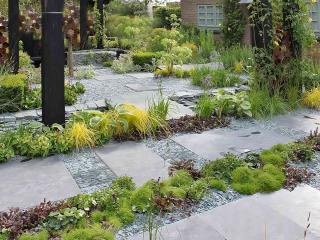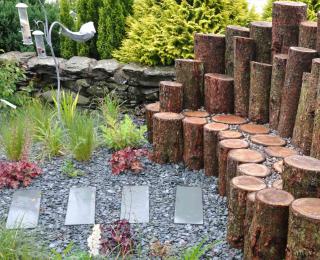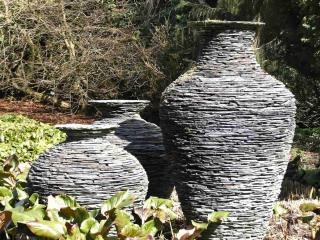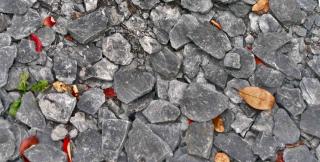

Slate mulch will make for most striking contrasts together with your plants.
Key slate mulch facts
Availability – regional
Cost – low
Ornamental value – deep gray
Ornamental layer – 2-4 in (5-10 cm)
Soil enrichment – doesn’t make soil alkaline
Renew rate – every three years, dig out & sift
This dark gray stone evokes the harsh weather of Brittany or the immediately charming Japanese garden. Slate mulch is simply perfect for plants that love acidic soil, such as hydrangea, rhododendron or camellia. Long-lasting, it is easy to set up.
Read also:
Slate mulch stands out for its ornamental properties and flat, surface-covering capabilities. Also a natural source of iron, its gray and sometimes amber color is what makes it radiate a feeling of rough, harsh nature.

Depending on where the slate comes from, slate mulch color can be pencil-gray, blue, black and even purple or green. This is due to differences in chemical composition of the rock.
Since it reflects light upwards, it helps provide light for sun-loving plants even when not planted in full sun.
Simply layer the mulch out in a layer about 3 inches thick (8 cm). It’s ok if it isn’t a very even layer.
To avoid breathing in slate dust, wear a dust mask.
Slate chips are sharp-edged. Wear gloves to avoid wounds and make spreading easier.

A sturdy rake will do the trick.
Use a strong pail with a strong handle.
Best is to set the bag of slate mulch on a strong work bench.
After three or four years, soil and dirt tend to come up and cover the slate mulch. To bring the flower or shrub bed back to its original elegance, you can either chose to buy new slate mulch, or to dig up the previous one and clean it up.
A layer of fresh slate mulch needn’t be as thick as the original layer.
You can recover your previous slate mulch relatively easily.
 Use a mesh wire drum or a half-inch sieve frame (1 cm sieve) to sift the soil and dirt out. Drums used to topdress lawns are perfect for this.
Use a mesh wire drum or a half-inch sieve frame (1 cm sieve) to sift the soil and dirt out. Drums used to topdress lawns are perfect for this.Recovering your slate is a great and inexpensive way to get your garden look astounding again. You’ll be maximizing your past investment for years!
It’s usually possible to find slate mulch in garden stores.

Get in touch with a local roof-builder to recycle their waste such as broken shale shingles, old roof shingles being replaced, etc.
It’s a great way to recycle in the garden!
Slate mulch is very similar to shale mulch. Any supplier having one will surely be able to find the other.
If you want your hortensia to bloom in a beautiful blueish tint, mulch its base with slate.
Slate naturally releases alumina, which changes the flower’s color.